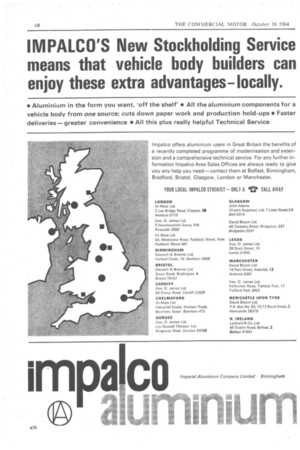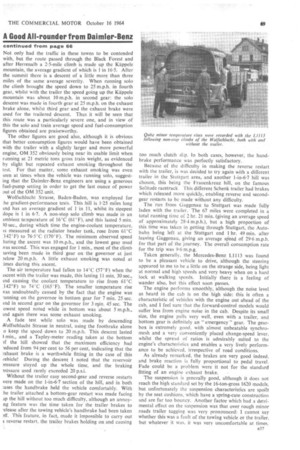IMPALCO'S New Stockholding Service means that vehicle body builders can enjoy these extra advantages locally.
Page 70

Page 71

Page 68

If you've noticed an error in this article please click here to report it so we can fix it.
Impala) offers aluminium users in Great Britain the benefits of a recently completed programme of modernisation and extension and a comprehensive technical service. For any further information Impale° Area Sales Offices are always ready to give you any help you need—contact them at Belfast, Birmingham, Bradford, Bristol, Glasgow, London or Manchester. Not only had the traffic in these towns to be contended with, but the route passed through the Black Forest and after Herrenalb a 2-5-mile climb is made tip the Kappele mountain, the average gradient of which is I in 16-5. After the summit there is a descent of a little more than three miles of the same average severity. When running solo the climb brought the speed down to 25 m.p.h. in fourth gear, whilst with the trailer the speed going up the Kappele mountain was about 10 m.p.h. in second gear: the solo descent was made in fourth gear at 25 m.p.h. on the exhaust brake alone, whilst third gear and the exhaust brake were used for the trailered descent. Thus it will be seen that this route was a particularly severe one, and in view of this the solo and train average speed and fuel-consumption figures obtained are praiseworthy.
The other figures are good also, although it is obvious that better consumption figures would have been obtained with the trailer with a slightly larger and more powerful engine, OM 352 obviously being near its usable limit when running at 21 metric tons gross train weight, as evidenced by slight but repeated exhaust smoking throughout the test. For that matter, some exhaust smoking was even seen at times when the vehicle was running solo, suggesting that the Daimler-Benz engineers are using a generous fuel-pump setting in order to get the last ounce of power out of the OM 352 unit. '
Wolfschlucht Strasse, Baden-Baden, was employed for :he gradient-performance tests, This hill is 1-25 miles long ind has an average gradient of 1 'in 11, whilst its steepest dope is 1 in 6-7. A non-stop solo climb was made in an imbient temperature of 16°C (61°F), and this lasted 5 min. 30 sec., during Which time the engine-coolant temperature, is measured at the radiator header tank, rose from 61°C :142°F) to 76-5°C (170°F). The minimum observed speed luring the ascent was 10 m.p.h., and the lowest gear used was second. This was engaged for 1 min., most of the climb laving been made in third gear on the governor at just )elow 20 m.p.h. A little exhaust smoking was noted at imes during this ascent.
The air temperature had fallen to 14°C (57°F) when the iscent with the trailer was made, this lasting 11 min. 30 sec., ind causing the coolant temperature to rise from 61°C .142°F) to 74°C (I65°F). The smaller temperature rise was undoubtedly caused by the fact that the engine was -tinning on the governor in bottom gear for 7 min. 25 sec. Ind in second gear on the governor for 3 nun. 45 sec. The owest speed noted while in bottom was about 5 m.p.h., ind again there was some exhaust smoking.
A fade test while solo was made by descending Nolfsehlucht Strasse in neutral, using the footbrake alone o keep the speed down to 20 m.p.h. This descent lasted
min., and a Tapley-meter reading taken at the bottom )f the hill showed that the maximum efficiency had -educed from 94 per cent to 56 per cent, indicating that the :xhaust brake is a worthwhile fitting in the case of this /elide! During the descent I noted that the reservoir nessure stayed up the whole time, and the braking nessure used rarely exceeded 20 p.s.i.
Without the trailer easy second-gear and reverse restarts were made on the 1-in-6-7 section of the hill, and in both :ases the handbrake held the vehicle comfortably. With he trailer attached a bottom-gear restart was made facing ip the hill without too much difficulty, although an annoyrig feature was the time taken for the trailer brakes to -elease after the towing vehicle's handbrake had been taken )ff. This feature, in fact, made it impossible to carry out
reverse restart, the trailer brakes holding on and causing too much clutch slip. In both cases, however, the handbrake performance was perfectly satisfactory.
Because of the difficulty in making the reverse restart with the trailer, is was decided to try again with a different trailer in the Stuttgart area, and another I-in-6-7 hill was chosen, this being the Frauenkreuz hill, on the famous Solitude racetrack This different Schenk trailer had brakes which released more quickly, enabling reverse and secondgear restarts to be made without any difficulty.
The run from Gaggenau to Stuttgart was made fully laden with the trailer. The 67 miles were completed in a total running time of 2 hr. 21 min. (giving an average speed of approximately 284 m.p.h.), but a high proportion of this time was taken in getting through Stuttgart, the Autobahn being left at the Stuttgart end I hr. 49 min. after leaving Gaggenau, giving an average sliced of 29-6 m.p.h. for that part of the journey. The overall consumption rate for the trip was 9-6 m.p.g.
Taken generally, the Mercedes-Benz L1113 was found to be a pleasant vehicle to drive, although the steering appeared tome to he a little on the strange side, being light at normal and high speeds and very heavy when on a hard lock at walking speeds. Initially there is a feeling of wander also, but this effect soon passes.
The engine performs smoothly, although the noise level as heard in the cab is on the high side: this is often a characteristic of vehicles with the engine out ahead of the cab, and I feel sure that the forward-control models would suffer less from engine noise in the cab. Despite its small size, the engine pulls very well, even with a trailer, and bottom gear is definitely an " emergency " gear. The gearbox is extremely good, with almost unbeatable synchromesh and a very conveniently placed change-speed lever, whilst the spread of ratios is admirably suited to the engine's characteristics and enables a very lively performance to be achieved, irrespective of road conditions.
As already remarked, the brakes are very good indeed, and brake reaction is fully proportional to pedal travel. Fade could be a problem were it not for the standard fitting of an engine exhaust brake.
The suspension is generally good, although it does not reach the high standard set by the 16-ton-gross 1620 models, but unfortunately the suspension characteristics are spoilt by the seat cushions, which have a spring-case construction and are far too bouncy. Another factor which had a detrimental effect on the suspension was that over rough minor roads trailer tugging was very pronounced: I cannot say whether this was a fault of the towing vehicle or the trailer, but whatever it was, it was very uncomfortable at times.
was incredibly long: forward-control models have a conventional type of handbrake lever, and I feel that this should be incorporated in the semi-forward-control chassis for maximum efficiency.
Very good acceleration times were obtained with the 1113 in solo condition, and with the weight doubled by addition of the drawbar trailer the acceleration times were approximately doubled also-certainly as far up as 30 m.p.h. When running with the trailer it was still possible to start off from rest quite smoothly in second gear, and I was very surprised at the comparative smoothness of the engine and transmission when pulling away from 10 m.p.h. in top gear: a quite remarkable performance for an engine of only 5-675-litres capacity moving a weight of more than 20-5 tons at under 600 r.p.m. in top gear. Full-throttle 1134 checks showed the gear ratios to be well spread, with bottom gear giving approximately 5 m.p.h., second 10 m.p.h., third 19 m.p.h. and fourth 31 m.p.h.
In all, seven sets of fuel-consumption figures were taken with the L 1113, and these are listed in the accompanying data panel. The full-throttle runs on the Autobahn are self-explanatory, and the normal roads" tests were made over a gently undulating stretch between Gernsbach and Muggensturm, the total distance involved being about 23 miles, over which maximum speed was 40 m.p.h.
The " hilly route used for two of the tests really was hilly, however, starting and finishing at Rastatt and passing through Ettlingen, Herrenalb, Loffenau and Gernsbach.




































































































































